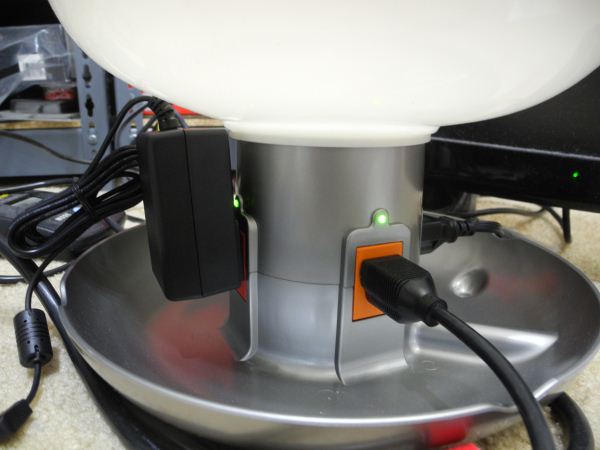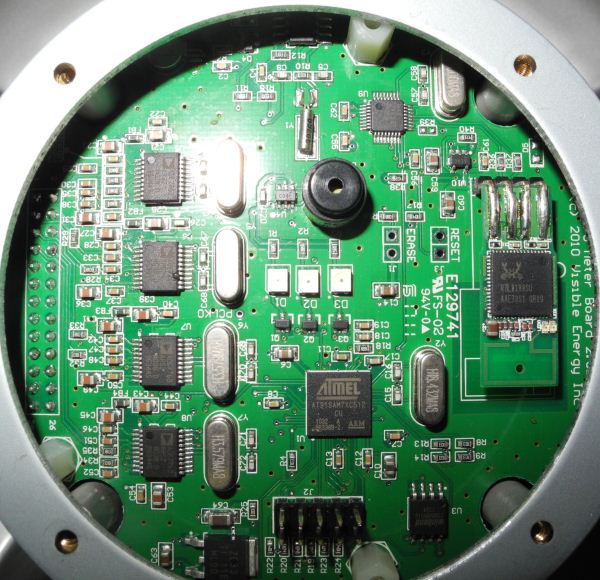Visible Energy UFO Power Center Smart Power Strip Review
by Ganesh T S on October 26, 2012 8:00 AM EST- Posted in
- Home Automation
- Wi-Fi
- Visible Energy
Hardware and Industrial Design
The industrial design of the UFO Power Center is definitely eye-catching, and may make for a good fit in some entertainment centers. Due to the non-standard design, it is sure to elicit polarizing opinions. Unfortunately, we are not great fans of the current size and shape of the unit. With a diameter of 12” and a height of 5”, it is too big to fit in most places where space is at a premium.
In addition, the clearance above and below the receptacles is not large enough for some ‘wall wart’ adapters, as shown in the photograph below (The adapter belongs to the Iomega EZ network attached hard disk). It is not possible to install the adapter with the output wire pointing downwards. Keeping the output wire pointed upwards (as shown below) makes it impossible to close the dome without dislodging the precariously positioned adapter from the receptacle.
Visible Energy has a blog post explaining the reason behind the size of the unit, and we will leave it to the reader to be the final judge.
Most of us are interested in the internals of the unit. Disassembling the unit exposed the following main components:
- 4x Schrack RT314F05 power relays, each of which is rated for 250V / 16A
- TI ULN2803A for switching the relay
- TNY278GN power switcher
- 4x ADE7763 energy metering ICs
- Atmel AT91SAM7XC512-CU microcontroller
- Realtek RTL8188SU 802.11b/g/n 1T1R WLAN Controller with USB 2.0 Interface
Despite being equipped with four relays capable of handling 16A each, Visible Energy has decided to play it safe by rating the whole unit for a maximum of 15A only.
A number of Wi-Fi companies (including TI, Qualcomm - Atheros and Marvell) have recently introduced a low cost system integrating the Wi-Fi radio and a MCU. Visible Energy currently uses two distinct chips for this, one from Atmel and the other from Realtek. The big vendors require complicated NDAs and large upfront payments. Given the projected low volume nature of the UFO Power Center (after all, it is Visible Energy’s first product) we actually need to applaud the company for choosing off-the-shelf components and making the entry price acceptable.
The Atmel microcontroller coordinates the operation of the unit as it sets up the ADE7763 chips for energy and power measurement. Power usage is computed and updated every second, while the energy usage is continuously monitored, but gets stored out once every five minutes. It also responds to the network requests from the Wi-Fi chip and sends back the requested data or modifies the relay status as applicable. The microcontroller also phones back home (to service.visiblenergy.com) with the energy / power data and socket status while also fetching any actions to be completed. These actions may have been set up by the user over the cloud interface. This pull mechanism enables control over the Internet without opening up any ports in the router for the unit. The downside is the fact that any change made to the socket status over the Internet could potentially take up to a minute to get reflected in the unit. Over the local network (for the iOS app / custom scripts using the open APIs), this is not a problem.
In addition, there are a number of other components such as a dedicated RTC (real time clock) and 1 MB of Flash memory for storage of energy history. This allows storage of the energy history of each socket for the previous 2 months at the minimum.
The LEDs and the Wi-Fi radio / miscellaneous board components contribute to a total power consumption of around 2.2 W even when nothing is connected to the sockets. By turning off the LEDs and the relays, it is possible to bring down the power to around 1.5 W.













35 Comments
View All Comments
Mr Perfect - Friday, October 26, 2012 - link
I'd like to see what Anandtech can find in the way of hardwired rackmountable options too.We've been looking for such a device, and so far all we've got is a non-rackable device that doesn't seem to be designed to work as part of a system. There are three of them so far with plans for more, but they can't tie back to a central server for management, each unit needs to be addressed individually through a web interface. Does anyone know of hardwired, rackmountable PDUs that can be centrally controlled?
ganeshts - Friday, October 26, 2012 - link
This one is 'rackmountable' in the sense that it can be vertically mounted along side rail:http://www.digital-loggers.com/vpdu.html
No power measurement / energy management features, though.
Mr Perfect - Wednesday, October 31, 2012 - link
Thanks. They've got a couple interesting things. Our devices are PoE, so maybe just getting their rackmountable PoE PDU/injector would work better then putting the existing PoE injectors on a separate PDU.Rick83 - Friday, October 26, 2012 - link
Looks to me like this is a brilliant use case for PoE.That way at least you only have one wasteful transformer in your home, and it can also feed your phone, attached switches, APs and other small light/switch-gadgets and sensors.
PoE should be obligatory for any IP-based home automation system.
Mr Perfect - Friday, October 26, 2012 - link
It could work, but would be kind of limited. PoE can deliver 25.5 watts of power, so if the UFO uses 2.2 watts all by itself, you've only got about 23 watts to power your devices. Also, the PoE delivers as DC. You'd either need to throw in a DC to AC converter, or just make it a USB charger.taltamir - Friday, October 26, 2012 - link
What is a PoE?ganeshts - Friday, October 26, 2012 - link
PoE = Power Over EthernetPoE makes sense for non-Wi-Fi IP cameras and other such devices. Not sure it makes sense for this type of product.
ZETAPIERRE - Friday, October 26, 2012 - link
PoE would be an RJ45 cable. Since this plugs into an AC outlet already, there's no need to bring power via the Ethernet cable. WiFi eliminates the need for the Ethernet cable.ZETAPIERRE - Friday, October 26, 2012 - link
We have units that do the same thing with hardwired Ethernet. The problem I found is that I don't have Ethernet near every outlet, like behind the refrigerator. So, we re-designed ours to use WiFi and now we can place them everywhere. We can also use them to control the lights in the house during Xmas, they can all go on and off at the same time.Shadowmaster625 - Friday, October 26, 2012 - link
This is an absolute disgrace. There is no way this is worth $130, that is just pure madness. I built my own relay board that takes usb power from my tv and controls a relay to power my home theater receiver. So when my pc goes to sleep, my tv goes to sleep with it, and since its usb port shuts off, it turns off the receiver too. Simple $5 solution.I bought a serial (RS232) AC current sensor off ebay for $13 and built my own power usage logger. I've used it to profile my pc's. Yet another <$20 solution. Taking some overpriced gimmick and slapping wifi on it is just blasphemy.